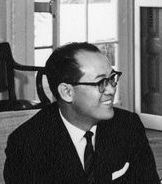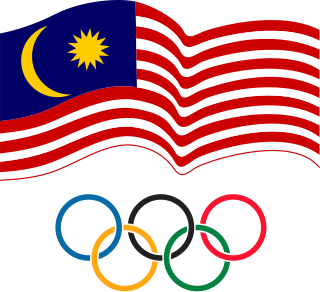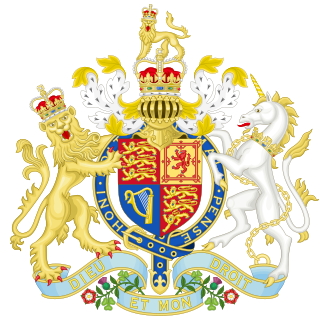The Treaty of London was signed on 8 February 1956 to set up the independent Federation of Malaya, which achieved its independence on 31 August 1957. [1]

East Malaysia, or the Borneo States, also known as Malaysian Borneo, is the part of Malaysia on and near the island of Borneo, the world's third-largest island. East Malaysia comprises the states of Sabah, Sarawak, and the Federal Territory of Labuan. The small independent nation of Brunei lies sandwiched between Sabah and Sarawak. To the south and southeast is the Indonesian portion of Borneo, Kalimantan. East Malaysia lies to the east of Peninsular Malaysia, the part of the country on the Malay Peninsula. The two are separated by the South China Sea.

The Malaysian Indian Congress is a Malaysian political party. It is one of the founding members of the coalition Barisan Nasional, previously known as the Alliance, which was in power from when the country achieved independence in 1957 until the elections in 2018. The party was among the first to fight for Malayan Independence and is one of the oldest parties in Malaysia.

The Federation of Malaya was a federation of what previously had been British Malaya, comprising eleven states that existed from 1 February 1948 until 16 September 1963. The Federation became independent on 31 August 1957, and in 1963, Malaysia was formed when Malaya united with Singapore, North Borneo, and Sarawak.
The states and federal territories of Malaysia are the principal administrative divisions of Malaysia. Malaysia is a federation of 13 states (Negeri) and 3 federal territories.

Independence Day, is the official independence day of Malaya from the British Empire. It commemorates the Malayan Declaration of Independence of 31 August 1957, and is defined in Article 160 of the Constitution of Malaysia. The day is marked by official and unofficial ceremonies and observances across the country.

Singapore, officially the State of Singapore, was one of the 14 states of Malaysia from 1963 to 1965. Malaysia was formed on 16 September 1963 by the merger of the Federation of Malaya with the former British colonies of North Borneo, Sarawak and Singapore. This marked the end of the 144-year British rule in Singapore which began with the founding of modern Singapore by Sir Stamford Raffles in 1819. At the time of merger, it was the smallest state in the country by land area, but the largest by population.

Tun Omar Ong Yoke Lin was a Malaysian politician, diplomat and businessman. He was a founding member of the Malaysian Chinese Association, and was a key figure in the country's road to independence. Ong served various positions in the government of Malaya and Malaysia, as a Cabinet minister and ambassador.
This article lists important figures and events in Malayan public affairs during the year 1954, as well as births and deaths of significant Malayans.

Olympic Council of Malaysia, or commonly OCM or MOM, is the National Olympic Committee representing Malaysia. It is also the body responsible for Malaysia's representation at the Commonwealth Games.

The Malaysia Agreement or the Agreement relating to Malaysia between United Kingdom of Great Britain and Northern Ireland, Federation of Malaya, North Borneo, Sarawak and Singapore (MA63) was the agreement which combined North Borneo, Sarawak, and Singapore with the existing states of the Federation of Malaya, the resulting union being named Malaysia. Singapore was later expelled from Malaysia, becoming an independent state on 9 August 1965.

The Malaysia Act 1963 was an Act of Parliament of the United Kingdom. It came into operation on 31 July 1963.
Lee Boon Chim (1926–1998) was a Malaysian businessman and a pioneer of standard Malaysia rubber, who helped guide Malaysian rubber into becoming a valuable international commodity. He was also the Chairman of the Kuala Lumpur Commodity Exchange and later a Senator in the Malaysian Senate, participating in various government activities.

The Proclamation of Malaysia was a statement, written in English and Malay, that declared the merger of the Federation of Malaya with the State of Singapore and the British crown colonies of North Borneo and Sarawak into the new Federation of Malaysia, following the enactment of the Malaysia Agreement and the Malaysia Act 1963 that July. The merger came into effect on 16 September 1963, and the proclamation was delivered on that date by Prime Minister Tunku Abdul Rahman in the Stadium Merdeka in Kuala Lumpur.
The orders, decorations, and medals of Malaysia comprise a complex system by which Malaysians and qualified foreigners are honoured by the country's sovereign for actions or deeds that benefit their community or the country at large. Modelled on its British predecessor, the orders, decorations, and medals of Malaysia were created after formation of Malaysia. The honour system came to exist earlier during Federation of Malaya. During the British colonial times, honours were given under the British honour system. Johor was the first state to institute its own honours on 31 July 1880. Then, the other Malay states did the same.

The Malaysia Architecture Museum is an architecture museum in Malacca City, Malacca, Malaysia which exhibits various architectural materials, building models and concepts.

Tunku Abdul Rahman formed the second Rahman cabinet after being invited by Tuanku Abdul Rahman to begin a new government following the 19 August 1959 general election in the Federation of Malaya. Prior to the election, Rahman led the first Rahman cabinet, a coalition government that consisted of members of the component parties of Alliance Party. It was the 2nd cabinet of Malaysia formed since independence.
This article lists important figures and events in the public affairs of British Malaya during the year 1934, together with births and deaths of prominent Malayans.
Tun Mohamed Salleh bin Ismael was the second Inspector-General of Police of Malaysia, and the first Asian and ethnic Malay to hold that post, taking office on 29 March 1966. His predecessor was Claude Fenner. His work resulted in the "Salleh System", as well as the National Police Cadets and the Police Volunteer Reserve.
Miss International Malaysia is a beauty pageant based in Malaysia that sends the winner to the annual Miss International pageant. The pageant was conceived in 1960 and considered as the oldest international beauty pageant in Malaysia. The winner of Miss International Malaysia will represents her country at the Miss International pageant. On occasion, when the winner does not qualify for either contest, a runner-up is sent.